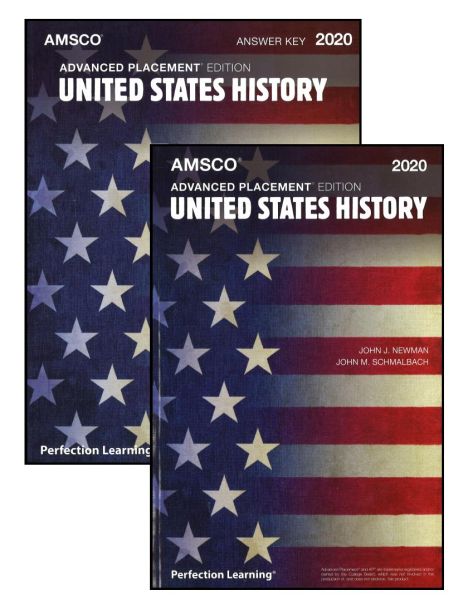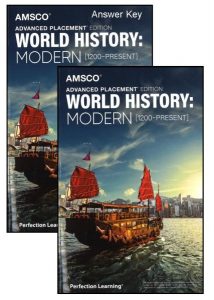Features
- correlated to the 2019 course exam description framework in the areas of historical thinking skills, reasoning processes, themes, and content
- updates put recent political events in context, including events since 2016
- includes more short-answer questions that use secondary sources, matching a change to the 2020 exam
- numerous high-quality primary sources offer students opportunities to analyze historical evidence, identify historical significance, and evaluate credibility
- an in-depth Introduction familiarizes students with historical thinking skills, reasoning processes, and course themes
- divided into nine Units (chronological periods), and eight themes, the text mirrors the structure of the 2019 AP U.S. History course exam description and reflects the effort to focus on trends rather than isolated facts
- students are provided with scaffolded guidance through a step-by-step development guide which explains how to answer the four question types—MCQs, SAQs, LEQs, and DBQs—on the exam
- end-of-chapter assessments include eight source-based multiple-choice questions and four sets of short-answer questions for review of the chapter and practice using AP historical thinking skills
- Think As a Historian features focus on one of the historical thinking skills or reasoning processes tested on the AP exam
- Historical Perspectives features at the end of each chapter address how historians have interpreted historical events in diverse ways
- the chapter conclusion features a thematically-organized list of key terms, people, and events reflecting the College Board focus on asking students to identify themes, not just events
- chapter assessments include eight multiple-choice items, each tied to a source as on the new AP exam, and even more high-quality short-answer questions using secondary sources, matching a change to the exam
- unit reviews offer comprehensive practice and insight into the long-essay and document-based questions found on the AP exam
- includes a complete practice exam with a revised exam format based on the 2019 Course Exam Description
- the Answer Key correlates each question to the College Board Curriculum Framework
- Narrative that is concise, accessible, and divided into 9 chronological periods
- Historical perspectives essay in each chapter
- History reasoning skills practiced in each chapter
- 8 source-based multiple-choice items in each chapter
- 4 short-answer questions in each chapter
- 10 DBQs included in the period reviews
- Long essay questions in each period review
- A Complete Practice Exam
Answer Key
- Provides answers or guidance for good responses for all questions
- Correlates text and questions to the AP United States History Course and Exam Description (Effective FALL 2019)
- Lists textbook pages that provide information supporting answers
Table of Contents:
- Preface
- Introduction
- Period 1: 1491 – 1607
- Period 2: 1607 – 1754
- Period 3: 1754 – 1800
- Period 4: 1800 – 1848
- Period 5: 1844 – 1877
- Period 6: 1865 – 1898
- Period 7: 1890 – 1945
- Period 8: 1945 – 1980
- Period 9: 1980 – Present
Features
- STRATEGIC Organization: The revised book aligns with the new organization of the course, including the 2019 College Board revisions to the course and exam description. The four periods consist of a total of nine units. This is critical for student success on the exam.
- INSPIRED Pre-1200 Content: Includes a new Prologue that prepares students for the study of history beginning ca. 1200. It surveys key developments in world history prior to 1200, such as the emergence of major world religions, the interactions between cultures through trade networks and migration, and the growth of and shifts in centers of population and innovation.
- IMPRESSIVE Unit Summary Sections: Ensuring students better grasp the larger trends in world history and practice history reasoning skills, each unit in the new edition concludes with an expanded summary that reviews the content of the unit by placing it in historical context.
- STIMULATING LEQs & DBQs: Additional high-quality long essay and document-based questions have been added to better prepare students for the toughest parts of the exam.
- FEATURES Scaffolded Learning Tasks: Guided instruction and practice is provided for each of the historical disciplinary practices or reasoning skills identified by the College Board.
- REINFORCES Writing Skills: Exercises throughout the text help prepare students to answer free-response questions on the exam.
- DEVELOPS College Readiness: Within text Test Prep tasks build comprehension and critical analysis skills through extended practice in evaluating author’s perspectives, analyzing sources, citing textual evidence to support arguments, and developing cohesive written arguments.
- HIGH QUALITY Summative Assessments: Includes a complete practice exam with a revised exam format based on the most current curriculum framework.
- COMPREHENSIVE Answer Key: Provides recommendations for what could be included in good responses and correlates each question to the curriculum framework.
- FLEXIBLE Design: This textbook can be used in a one-semester or one-year course.
- Prologue: History before c. 1200
- Period 1: c. 1200 to c. 1450
- Period 2: c. 1450 to c. 1750
- Period 3: c. 1750 to c. 1900
- Period 4: c. 1900 to the Present
Periods consist of 2 or 3 units and each includes
- A feature describing the context for the unit and identifying learning objectives
- 3 to 9 narrative topics
- A unit summary topic demonstrating an AP reasoning process
- A Historical Perspectives feature presenting diverse interpretations
- 4 long essay questions
- A Write As a Historian feature providing writing instruction and practice
- 1 document-based question
Each of the 63 narrative topics includes
- Content aligned to the AP Course Framework
- 1 set of stimulus-based multiple-choice questions
- 2 sets of short-answer questions, 1 based on a stimulus
- A Think As a Historian feature providing skills instruction and practice
The book ends with a practice exam based on the updated AP question styles.
A separate Answer Key is included.


